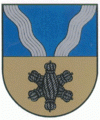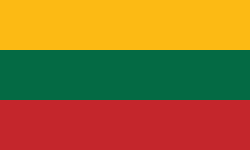Kupiškis (Kupiskis)
 |
* Centras (Center or Old Town; the oldest buildings in the city, town hall, sanitation and utility buildings, library, church, high school, blocks of flats, detached houses)
* Krantinė (high-rise housing complex between 4 and 5 floors, detached houses, shopping malls, preschool, primary school)
* Kraštiečiai (high-rise housing complex between 2 and 6 floors, shopping malls, preschool)
* Račiupėnai (a residential area; detached houses, middle school, business and technological school, bus station)
* Zuntė (a residential area; detached houses)
* Pramoninė teritorija (Industrial district; factories, warehouses, train station)
Archeological finds provide evidence that even in the 3rd and 2nd centuries BC people dwelt in the surroundings of Kupiškis. However, there is no information on when the very settlement was founded. The findings around the Aukštupėnai mound show that in the 8th century a wooden defence castle stood there.
Kupiškis was mentioned in historical sources for the first time in 1529. It was a property of Sigismund I the Old, the ruler of the Grand Duchy of Lithuania. From 1561 to 1565 it was a center of small ruler's center, belonging to the Upytė district and later the Ukmergė district. At that time the main road from Vilnius to Riga led via Kupiškis.
In 1616, the first Catholic church was built in Kupiškis. In 1781, the first school of the Lankasteriai family was established. The railway line from Daugavpils to Šiauliai to Liepāja was built in 1873.
Map - Kupiškis (Kupiskis)
Map
Country - Lithuanian_Soviet_Socialist_Republic_(1918–1919)
 |
 |
| Flag of Lithuania | |
Germany had lost World War I and signed the Compiègne Armistice on 11 November 1918. Its military forces then started retreating from the former Ober Ost territories. Two days later, the government of the Soviet Russia renounced the Treaty of Brest-Litovsk, which had assured Lithuania's independence. Soviet forces then launched a westward offensive against Estonia, Latvia, Lithuania, Poland and Ukraine in an effort to spread the global proletarian revolution and replace national independence movements with Soviet republics. Their forces followed retreating German troops and reached Lithuania by the end of December 1918.
Currency / Language
| ISO | Currency | Symbol | Significant figures |
|---|---|---|---|
| EUR | Euro | € | 2 |
| ISO | Language |
|---|---|
| LT | Lithuanian language |
| PL | Polish language |
| RU | Russian language |















